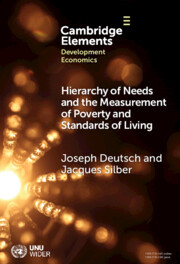Refine search
Actions for selected content:
26946 results in Economic history
Contributors
-
- Book:
- An Economic History of the Iberian Peninsula, 700–2000
- Published online:
- 22 February 2024
- Print publication:
- 29 February 2024, pp xiii-xiv
-
- Chapter
- Export citation
4 - The Polity, 1000–1500
- from Section II - The Medieval Economy, 1000–1500
-
-
- Book:
- An Economic History of the Iberian Peninsula, 700–2000
- Published online:
- 22 February 2024
- Print publication:
- 29 February 2024, pp 102-129
-
- Chapter
- Export citation
25 - The Iberian Economy in Comparative Perspective, 1800–2000
- from Part III - Industrialization and Catching Up, 1800–2000
-
-
- Book:
- An Economic History of the Iberian Peninsula, 700–2000
- Published online:
- 22 February 2024
- Print publication:
- 29 February 2024, pp 648-678
-
- Chapter
- Export citation
10 - Patterns of Iberian Economic Growth in the Early Modern Period
- from Part II - Globalization and Enlightenment, 1500–1800
-
-
- Book:
- An Economic History of the Iberian Peninsula, 700–2000
- Published online:
- 22 February 2024
- Print publication:
- 29 February 2024, pp 251-277
-
- Chapter
- Export citation
16 - Trade and the Colonial Economies, 1500–1828
- from Part II - Globalization and Enlightenment, 1500–1800
-
-
- Book:
- An Economic History of the Iberian Peninsula, 700–2000
- Published online:
- 22 February 2024
- Print publication:
- 29 February 2024, pp 409-442
-
- Chapter
- Export citation
21 - Iberian Financial System, 1800–2000
- from Part III - Industrialization and Catching Up, 1800–2000
-
-
- Book:
- An Economic History of the Iberian Peninsula, 700–2000
- Published online:
- 22 February 2024
- Print publication:
- 29 February 2024, pp 546-566
-
- Chapter
- Export citation
Section II - The Medieval Economy, 1000–1500
- from Part I - The Making of Iberia, 700–1500
-
- Book:
- An Economic History of the Iberian Peninsula, 700–2000
- Published online:
- 22 February 2024
- Print publication:
- 29 February 2024, pp 47-248
-
- Chapter
- Export citation

An Economic History of the Iberian Peninsula, 700–2000
-
- Published online:
- 22 February 2024
- Print publication:
- 29 February 2024

Shell Money
- A Comparative Study
-
- Published online:
- 15 February 2024
- Print publication:
- 21 March 2024
-
- Element
-
- You have access
- Open access
- HTML
- Export citation
Credit networks and business dynamics in a viceregal capital: Santafé de Bogotá in the age of Charles III
-
- Journal:
- Financial History Review / Volume 30 / Issue 3 / December 2023
- Published online by Cambridge University Press:
- 12 February 2024, pp. 330-354
-
- Article
- Export citation

Hierarchy of Needs and the Measurement of Poverty and Standards of Living
-
- Published online:
- 08 February 2024
- Print publication:
- 22 February 2024
-
- Element
-
- You have access
- Open access
- HTML
- Export citation
Institutional investors in the Portuguese credit market (1550–1800): The case of the Misericórdias
-
- Journal:
- Revista de Historia Economica - Journal of Iberian and Latin American Economic History / Volume 42 / Issue 1 / March 2024
- Published online by Cambridge University Press:
- 25 January 2024, pp. 91-119
- Print publication:
- March 2024
-
- Article
- Export citation
The rise and transformation of big business in Argentina (1913–1971)
-
- Journal:
- Revista de Historia Economica - Journal of Iberian and Latin American Economic History / Volume 42 / Issue 1 / March 2024
- Published online by Cambridge University Press:
- 22 January 2024, pp. 7-32
- Print publication:
- March 2024
-
- Article
- Export citation
Public debt as private liquidity: the Poincaré experience (1926–1929)
-
- Journal:
- Financial History Review / Volume 30 / Issue 3 / December 2023
- Published online by Cambridge University Press:
- 22 January 2024, pp. 308-329
-
- Article
- Export citation
7 - Rescuing Capitalism from the Capitalists
-
- Book:
- In Search of a Moral Foundation for Capitalism
- Published online:
- 23 November 2023
- Print publication:
- 07 December 2023, pp 153-181
-
- Chapter
- Export citation
4 - Humanism as a Moral Foundation
-
- Book:
- In Search of a Moral Foundation for Capitalism
- Published online:
- 23 November 2023
- Print publication:
- 07 December 2023, pp 68-94
-
- Chapter
- Export citation
Dedication
-
- Book:
- In Search of a Moral Foundation for Capitalism
- Published online:
- 23 November 2023
- Print publication:
- 07 December 2023, pp v-vi
-
- Chapter
- Export citation
1 - Introduction
-
- Book:
- In Search of a Moral Foundation for Capitalism
- Published online:
- 23 November 2023
- Print publication:
- 07 December 2023, pp 1-20
-
- Chapter
- Export citation
Index
-
- Book:
- In Search of a Moral Foundation for Capitalism
- Published online:
- 23 November 2023
- Print publication:
- 07 December 2023, pp 231-240
-
- Chapter
- Export citation
References
-
- Book:
- In Search of a Moral Foundation for Capitalism
- Published online:
- 23 November 2023
- Print publication:
- 07 December 2023, pp 217-230
-
- Chapter
- Export citation
